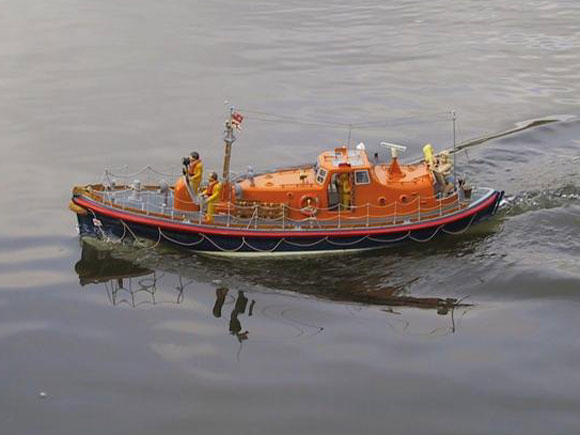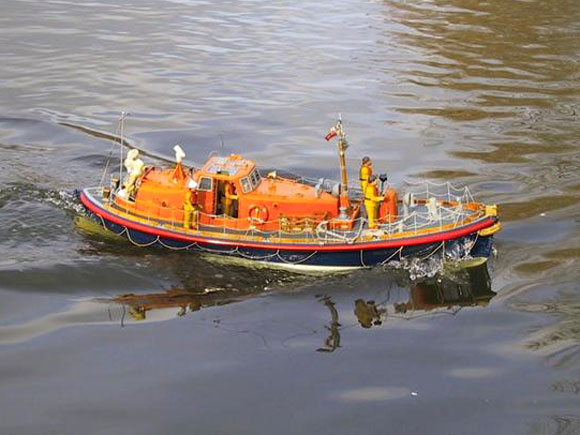
Pic 1: Damsels rescued and now being safely returned to the landing stage. Only a little first aid was needed apart from the application of some ‘after sun’ cream.
It was another very hot day with plenty of sun when a report came through that two young ladies had fallen from their sailing dinghy. This was a serious situation as they could very easily be eaten alive by a swan or canadian geese that frequent these waters! Moments later the lifeboat was launched, fortunately with a freshly charged set of batteries. The damsels in distress were quickly spotted and brought aboard. Later they were returned safely to the landing stage and all was well apart from some exposure to the sun! Unfortunately the dinghy could not be found and becomes another missing vessel deep down in Fairlands Valley Lake, lost without trace.

Pic 2: The lifeboat is back, but still afloat on station and about to be made ready for another mission on Fairlands Valley Lakes. The sun was very hot on the day the photographs were taken and the water was very calm.
Enjoy more Model Boats Magazine reading in the monthly magazine.
Click here to subscribe & save.
The lifeboat is a 47ft Watson type which was of a slipway-launched design and she was built mainly from wood with a twin diesel drive. The model is of RNLB Greater London II Civil Service No 30, which saw service for a number of years based at the Lifeboat Station on the pier at Southend-on-Sea, Essex. The lifeboat was purchased from voluntary contributions and civil service trade union membership fees.

Pic 3: The lifeboat sits and rides well on the water. The model has been tested successfully in some very choppy waves and high winds with no water taken into the working spaces – as good as a real full-size lifeboat.
The rescued damsels originally graced a soft drinks can support stand and the crew were once bandsmen moulded in resin and much modified with a Dremel drill and modelling clay.
The model was made from the Martins Models kit, much modified and is mostly of GRP with brass and steel fittings. She is 47ins long with a 13ins beam. Two Decaperm geared down motors provide the drive, being powered from two 6v 10ah lead acid gel batteries, which gives a maximum of about four hours sailing. The model has working navigation, cabin and deck lights as well as the searchlight plus a revolving radar scanner. The control dials in the wheelhouse are also illuminated. The lifeboat’s hooter was purchased from a motorbike shop and is very loud. Aldis and morse code effects are by Action electronics. A further 6v 2.8ah battery is used for lighting and sound effects.

Pic 4: The lifeboat returns to base after yet another successful rescue. Little has to be done other than recharge the batteries, clean the model up if need be and wait for the next call for assistance!
The Stevenage Model Boat Club meets at Fairlands Valley on Thursday afternoons and Sunday mornings throughout the year.




